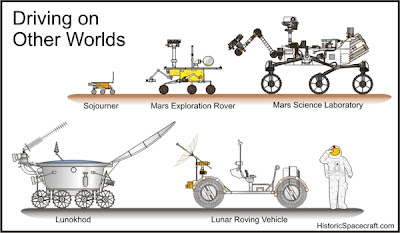Mars Curiosity is a big deal. In fact, in terms of the chronological history of all Mars exploration hardware, it's the biggest!

Spirit/Oppy Rover model, Sojourner and Curiosity
The Mars Science Laboratory (MSL), built at the NASA Jet Propulsion Laboratory, is 2.7 metres long (8.8 feet) and weighs in at 900 kilograms, or just under 1 ton. About 80kg of that bulk is an array scientific instruments (that I will describe in tomorrow's post).
The last two Mars Exploration Rovers (MER), Spirit and Opportunity, were each 1.57 metres and weighed 174 kilograms, each with about 7kg of instruments.
Rover Sojourner? The baby of the bunch, at 10.6kg...roughly the size of your microwave oven.

The Apollo LRV or Lunar Roving Vehicle, is truly the only space auto that matches Curiosity for size. Used for moon driving on Apollo 15, 16 and 17 missions, the battery-powered LRV was 3 metres long, though considerably lighter than MSL at a bouncy 210kg.
Curiosity, in comparison to past robots, could truly be considered the first "Mega-Rover" of the American space program. As the largest and most complex mobile science lab designed to visit another planet, MSL will attempt to determine if planet Mars ever had or still has any environmental conditions favorable to supporting life and search for clues in the terrain about possible past microbial life.
Note, that is somewhat different and more precise an objective than some of the spurious claims in the press about how Curiosity is "searching for life on Mars".

Only a few more days to go now before the mega-rover touches down! Curiosity's target will be a small landing ellipse at Gale Crater near the Martian equator. MSL, if not blown off course, will land near the base of Aeolis Mons, also often called "Mount Sharp", in Aelois Palus.
Curiosity is currently scheduled to land at approximately 1:31 am EDT Aug. 6 (10:31 p.m. PDT Aug. 5)... and even the dual LED large screens in New York's Time Square will be carrying the NASA TV feed live!




